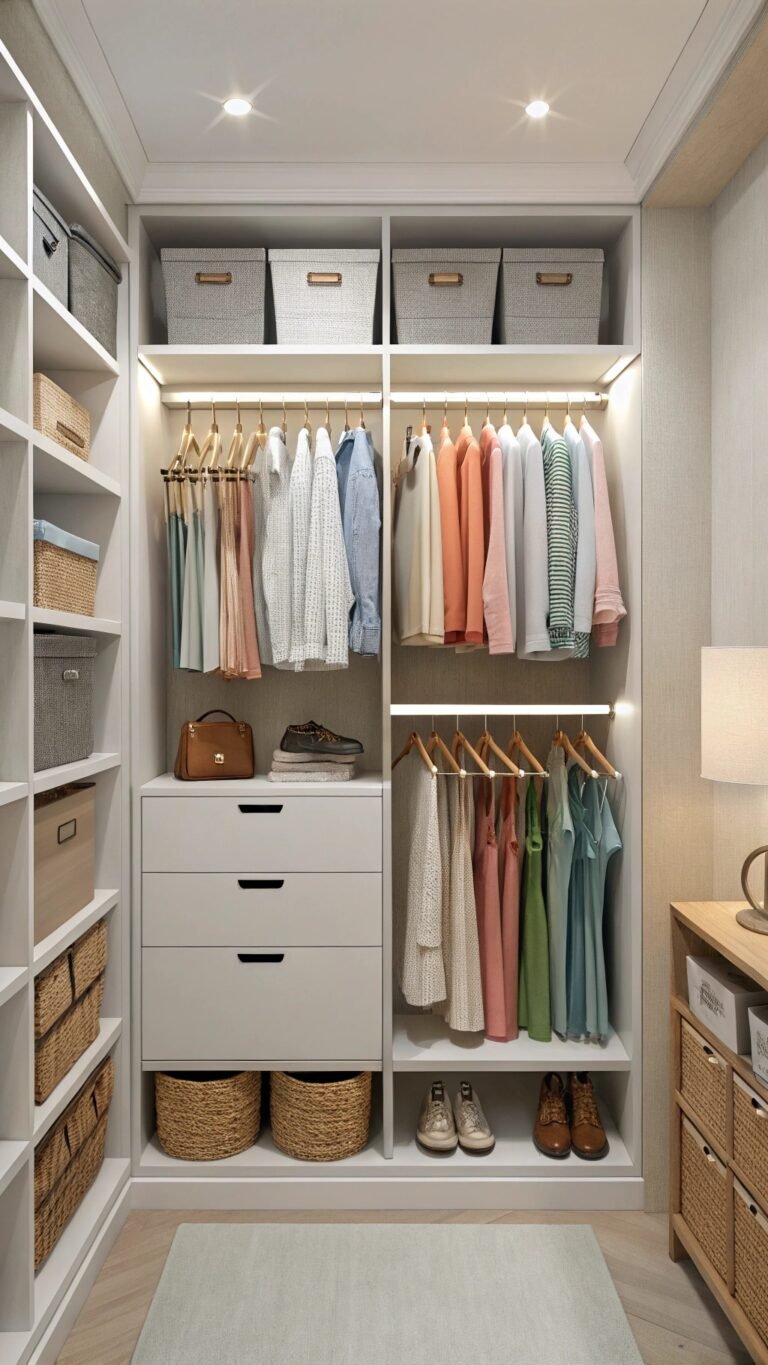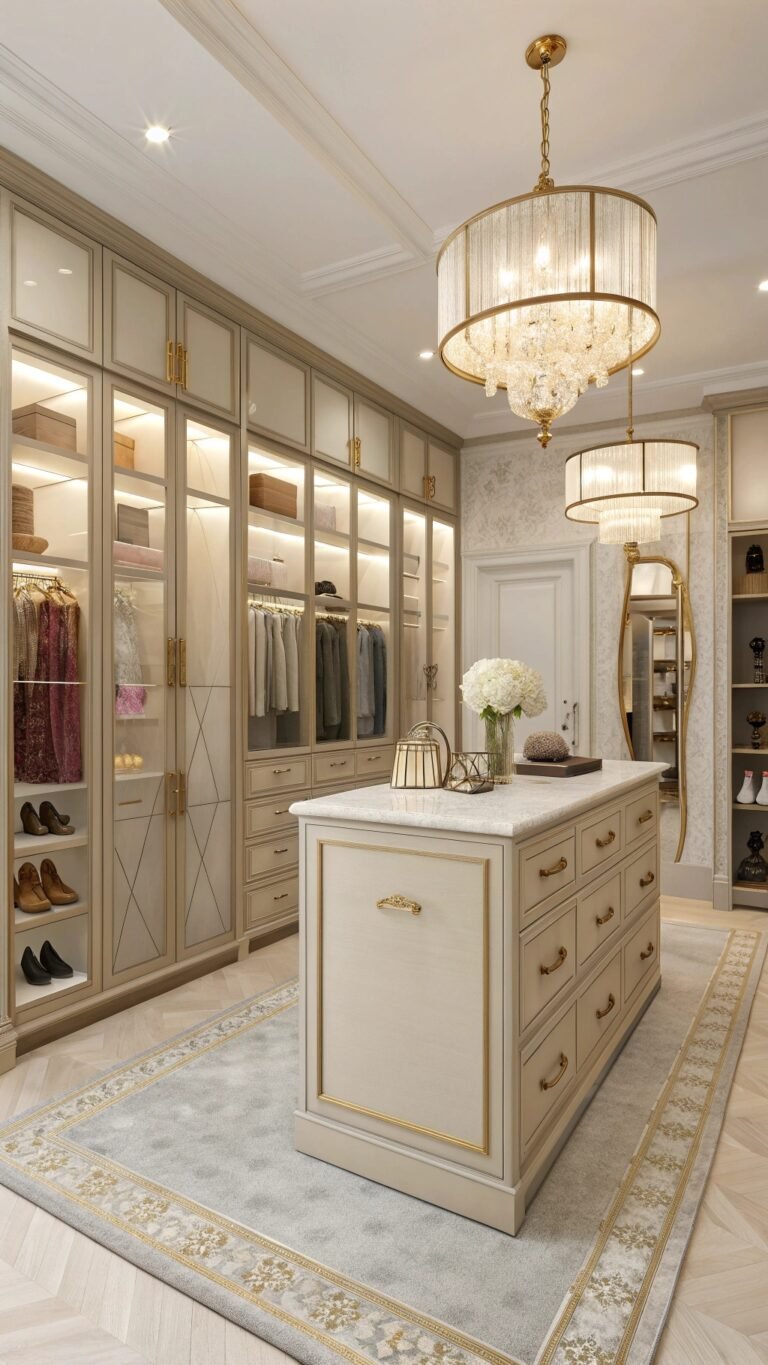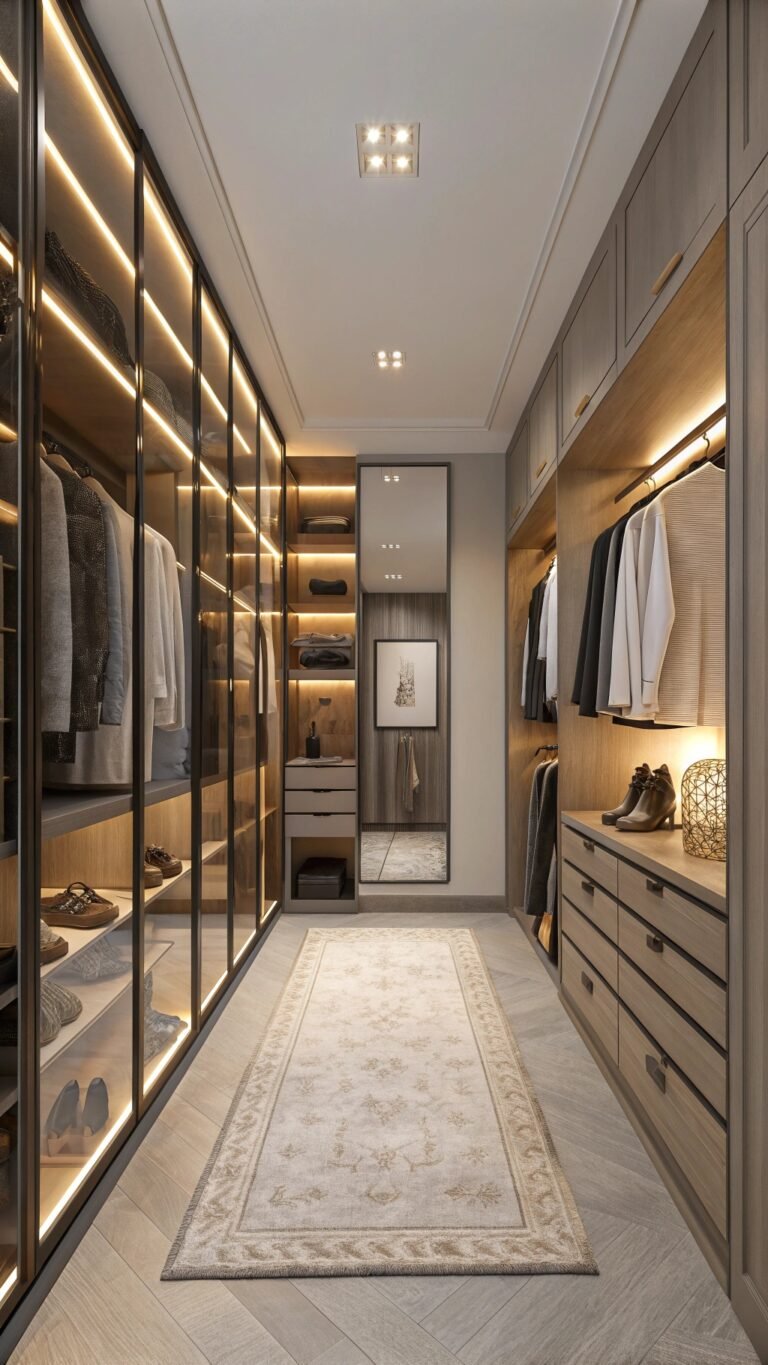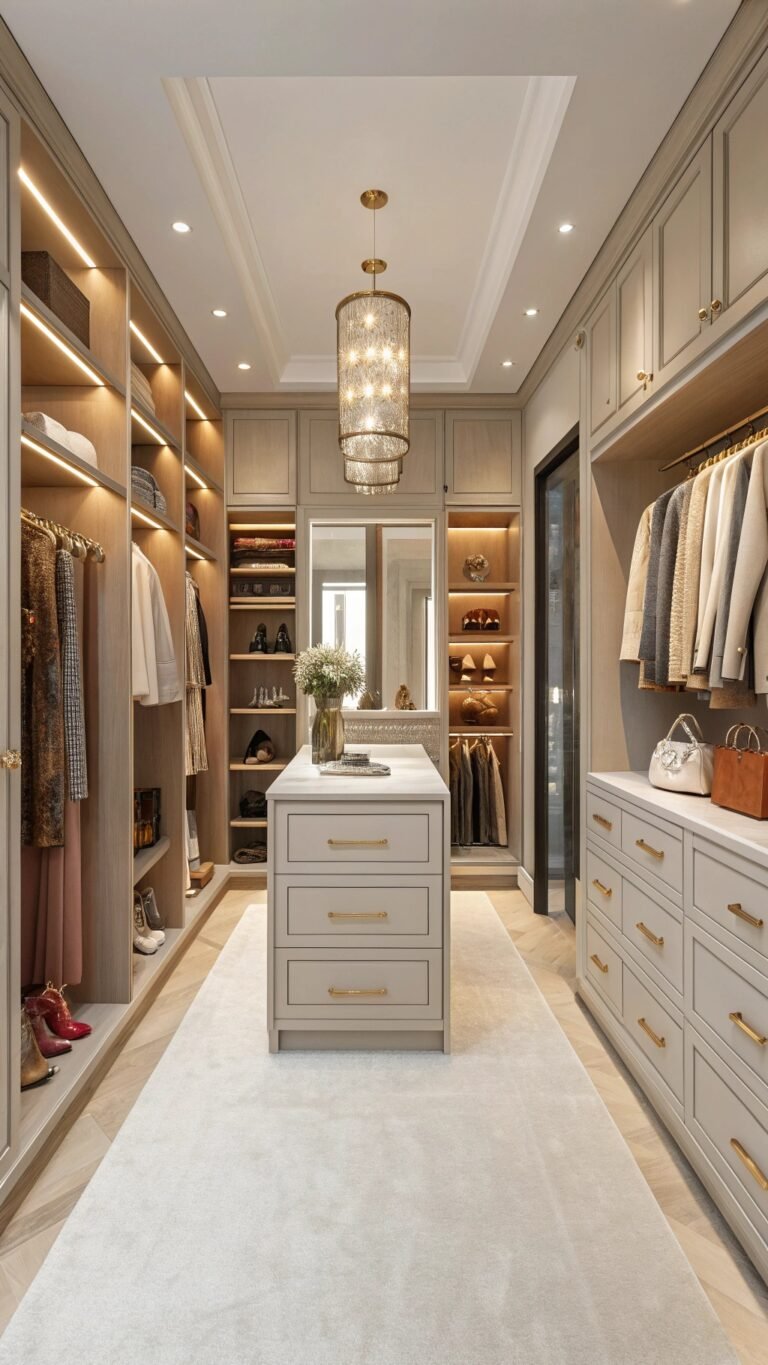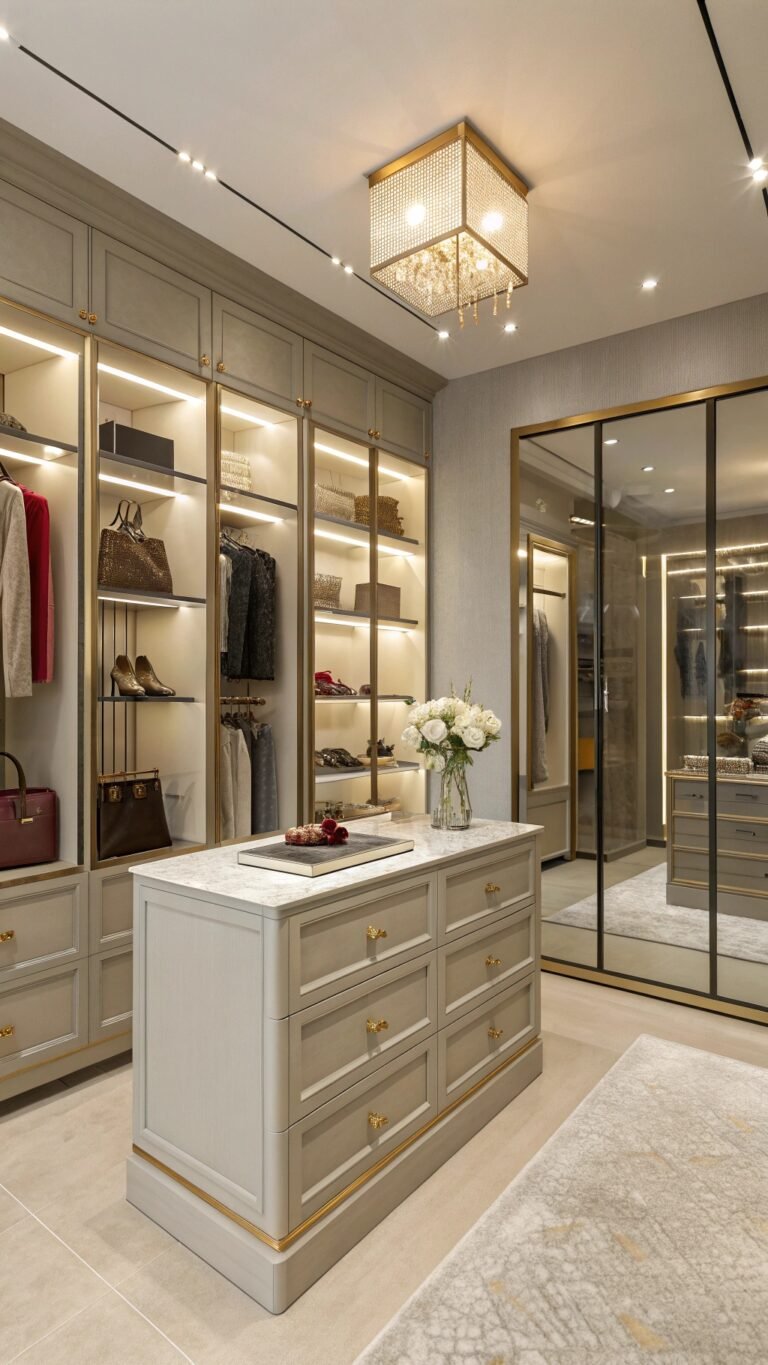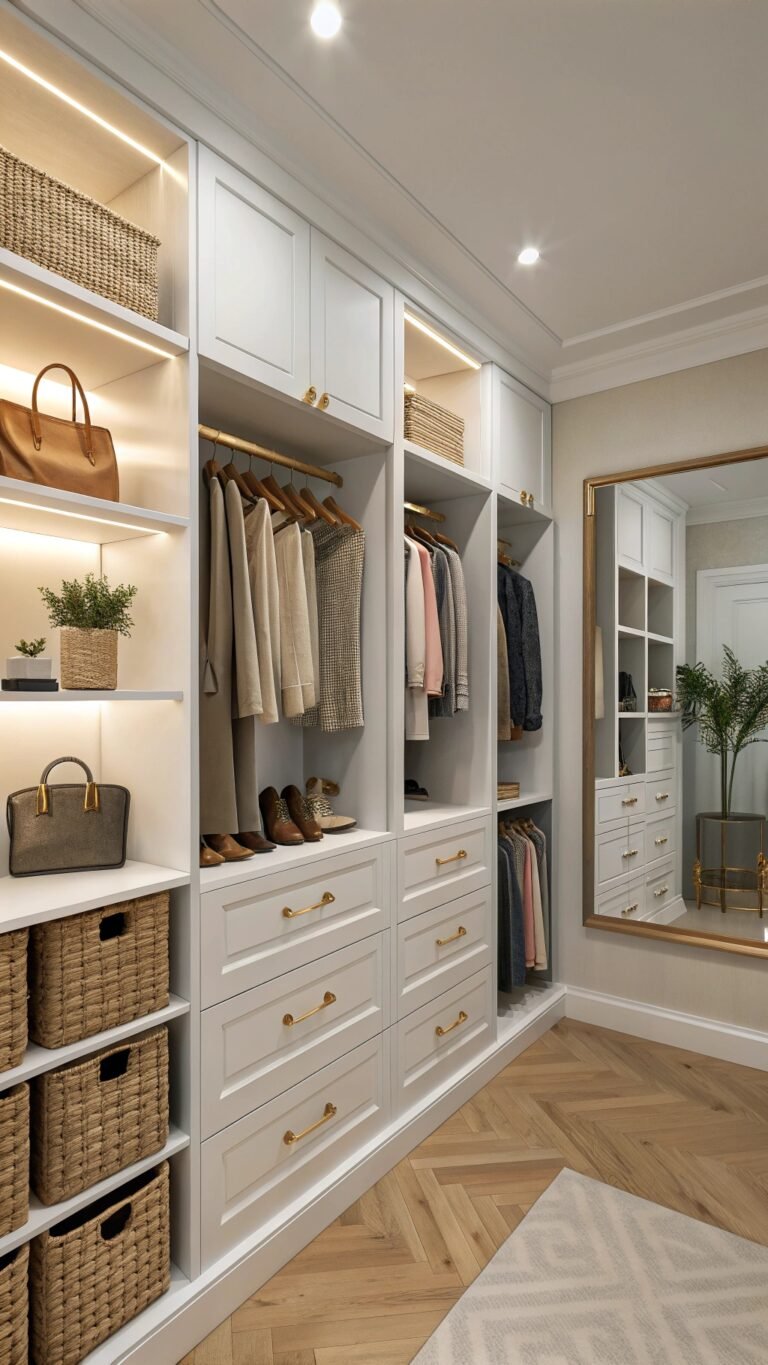Closet Designs: 15 Ideas That Look Luxe and Work Hard
Closet designs are the must-try decor trend because they deliver the fastest daily payoff: calm mornings, quicker outfit decisions, and bedrooms that feel bigger.
From floor-to-ceiling millwork to glass-front displays and lighting you actually want to use, these design-forward upgrades blend style with real-world function—no full remodel required.
1) Full-Height Sliding Doors
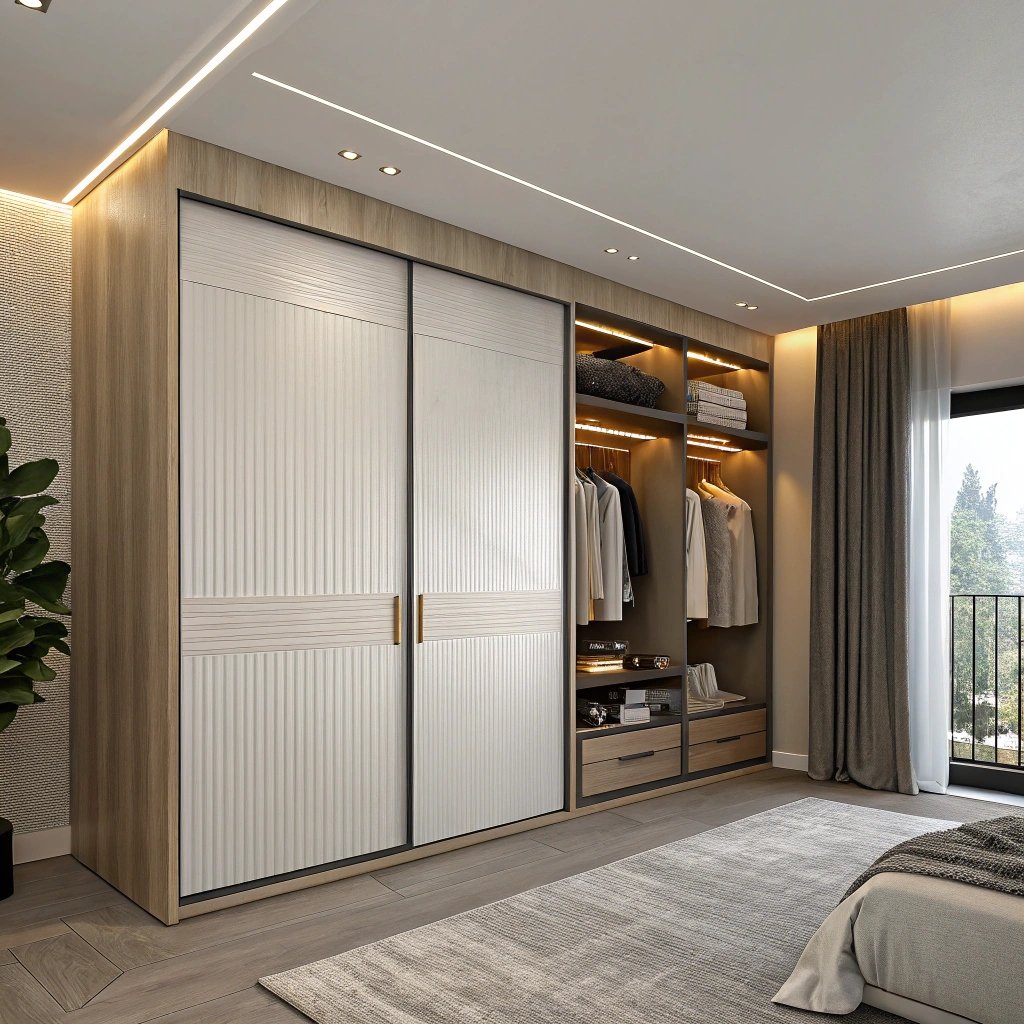
Wall-to-wall sliders clean up sightlines and save clearance in tight rooms. Conceal a mix of drawers, adjustable rails, and shelves behind a seamless facade.
With a ceiling-recessed track and a flush base, the elevation reads like a single panel. Choose soft-close hardware and dust brushes at the perimeter so the doors glide silently and keep interiors pristine.
What makes this unique:
Personalize each leaf: fluted, linen-wrapped, bronze mirror, or smooth lacquer—same color family, different textures. Add discreet finger pulls and a narrow shadow reveal for depth.
Inside, set up “drop zones” at the door positions so what you open is exactly where your most-used categories live. It’s sleek minimalism that still behaves like a working closet.
2) Floor-to-Ceiling Built-Ins
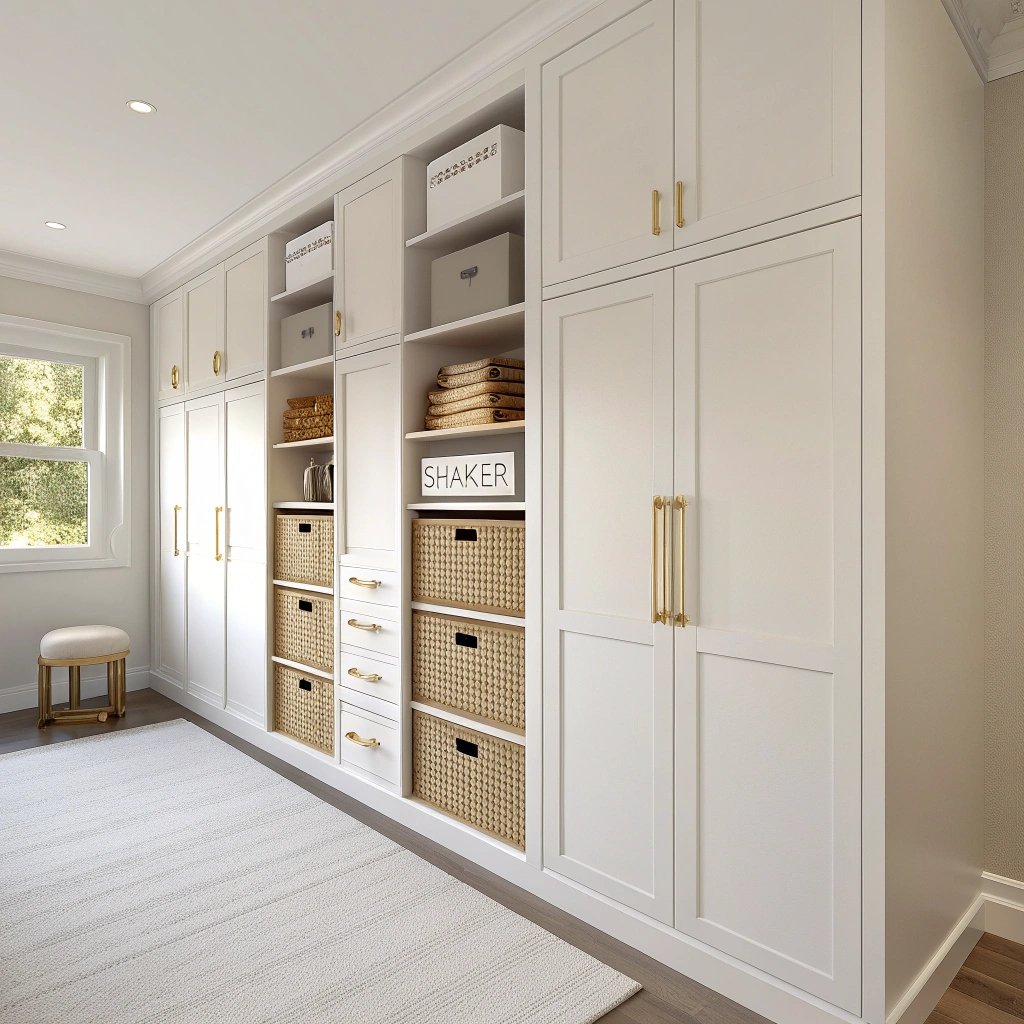
Take cabinetry to the ceiling to capture every inch. Mix closed doors for visual calm with a few open cubbies for everyday items.
Tall panels hide luggage and bulky bedding, while deep shelves protect knits from dust. Keep a consistent door style so the wall reads architectural, not “storage unit,” and plan a dedicated bay for long coats and dresses to preserve silhouette.
What makes this unique:
Divide the vertical into three zones: daily at eye level, occasional below, long-term up top. Add a slim niche for a foldable step stool and lidded, labeled boxes in the top third.
Repeat one hardware finish across the entire run and align door gaps with wall lines. The result feels custom, future-proof, and effortless to maintain season after season.
3) Glass-Front Display with Reeded Panels
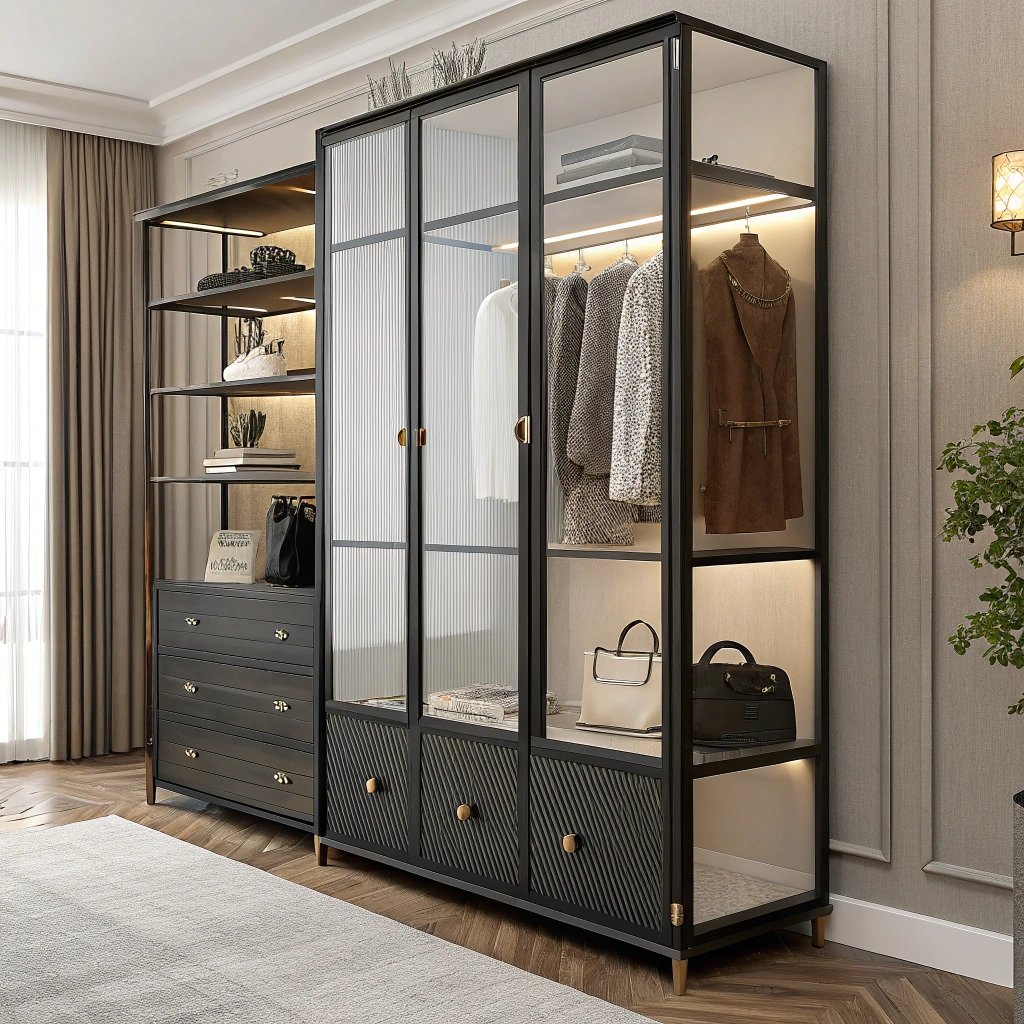
Reeded (fluted) glass hides visual noise while borrowing light, perfect for handbags, hats, and sneakers you want to see without dust.
Pair thin metal frames in black or satin brass with backlighting and a few clear-glass niches for “hero” pieces. The rhythm of the glass texture adds movement without clutter.
What makes this unique:
Blend “show” and “suggest” on purpose: reeded for bulk storage, clear for a curated vignette. Use linear magnets and soft-close hinges to prevent chatter, and specify warm 3000K LEDs for boutique vibes that flatter materials.
It feels like a mini shop installation—elevated, edited, and surprisingly forgiving of real-life chaos.
4) Walk-In with Island Vanity
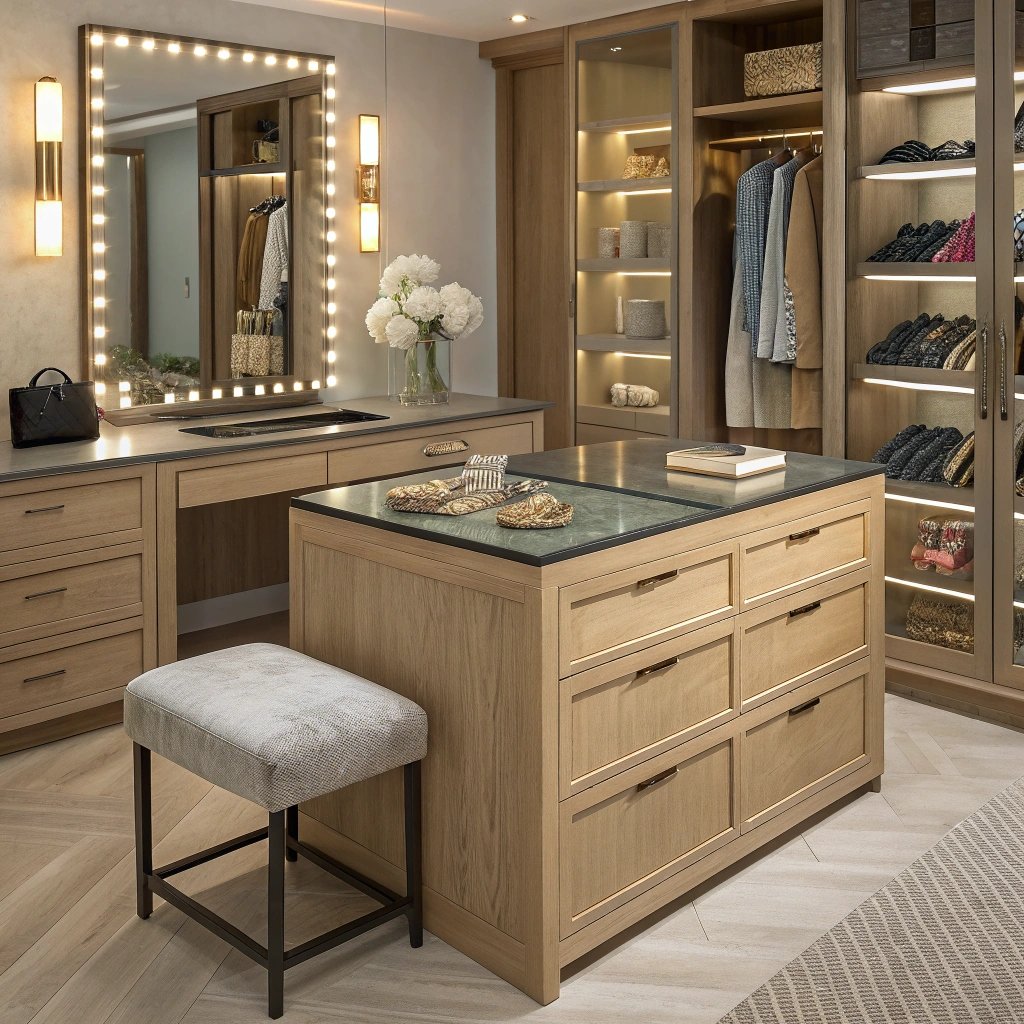
A modest island converts a walk-in from storage to dressing room. Top drawers handle intimates and tees; shallow velvet-lined trays protect jewelry and watches.
The countertop becomes a staging zone for packing or steaming. Add a vanity niche with a backlit mirror and an upholstered stool so getting ready feels like a daily ritual, not a scramble.
What makes this unique:
Hide power where you need it: a pop-up outlet for a steamer, USB-C for wearables, and a heat-safe pull-out for hair tools.
Keep a slim “in/out tray” for returns, tags, and tailoring tickets so loose bits never take over. The island becomes the project manager of the entire closet—quietly coordinating every task.
5) Open Wardrobe with Textured Curtain
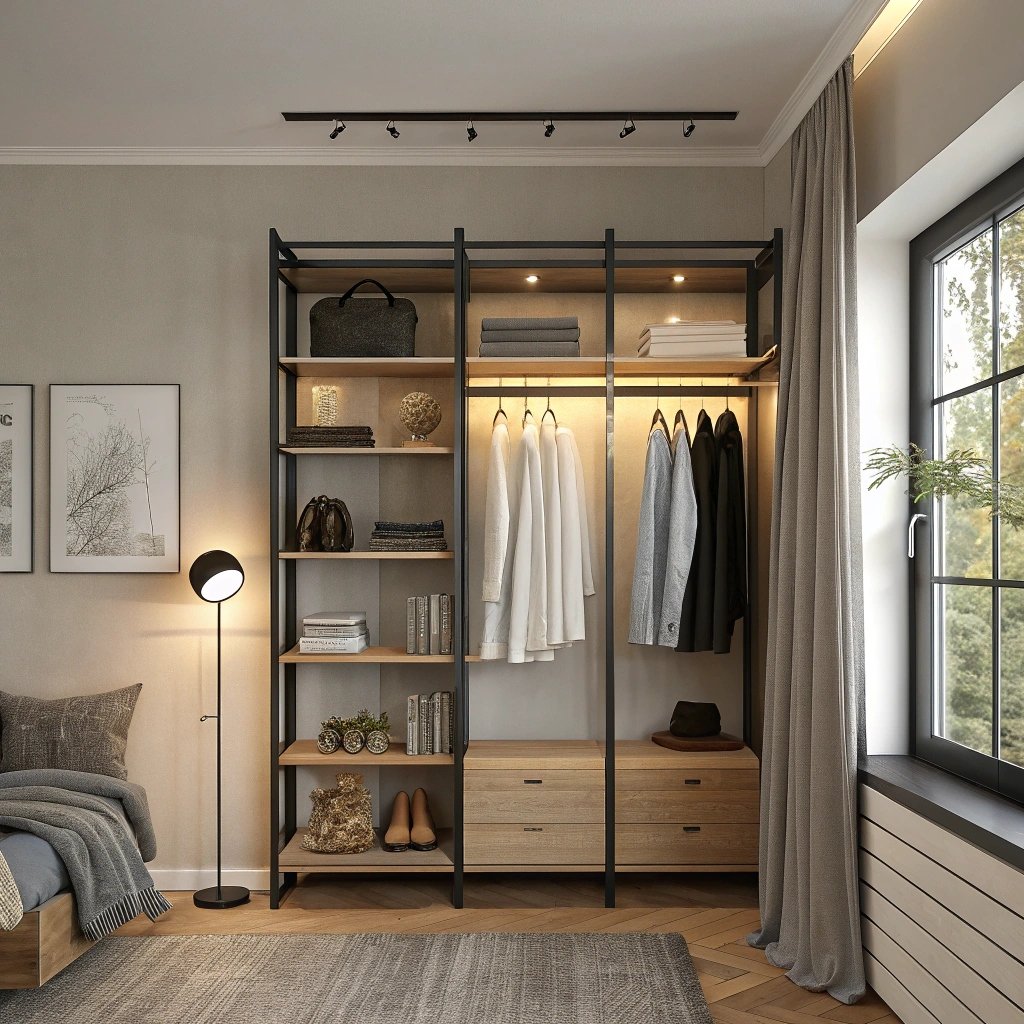
If doors aren’t in the budget—or you like the look—use an open system with a textured curtain to soften the view.
Linen or wool blend panels on a ceiling track hide visual breaks while allowing airflow. Combine double-hang sections, a single long-hang bay, and a few open shelves for folded knits and bags.
What makes this unique:
Create a color story: rails in blackened steel, shelves in blond oak, curtain in warm neutral. Add toe-kick lighting to guide sleepy feet and a single gallery light over a bag shelf for polish.
The curtain functions like a room divider: easy to open, easy to close, and easy to wash—versatile, tactile, and apartment-friendly.
6) Small Reach-In That Punches Above Its Weight
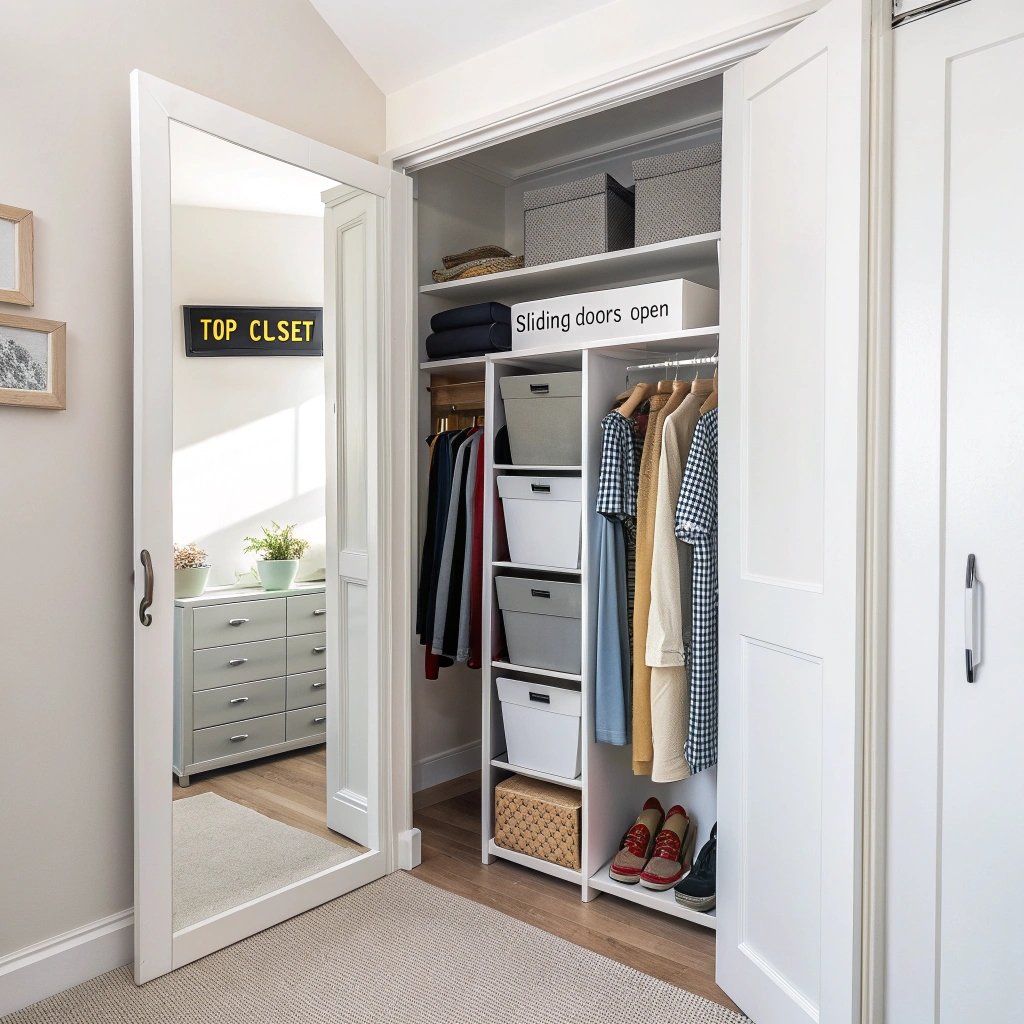
For shallow closets, run a tri-level layout: top uniform bins, mid rail with slim flocked hangers, and a low pull-out shoe drawer. Replace swinging doors with sliders or a fabric panel.
Add a valet hook to prep outfits without blocking access, and a mirror panel to bounce light back into the niche.
What makes this unique:
Use side-mounted pull-outs for belts and ties—hardware that thrives in minimal depth. A flip-down ironing pad lives on the inside panel, and a small sensor light kills the need to fumble for switches.
A few smart pieces of hardware convert a standard reach-in into a speedy, tidy mini-boutique.
7) Double-Hang with Adjustable Standards
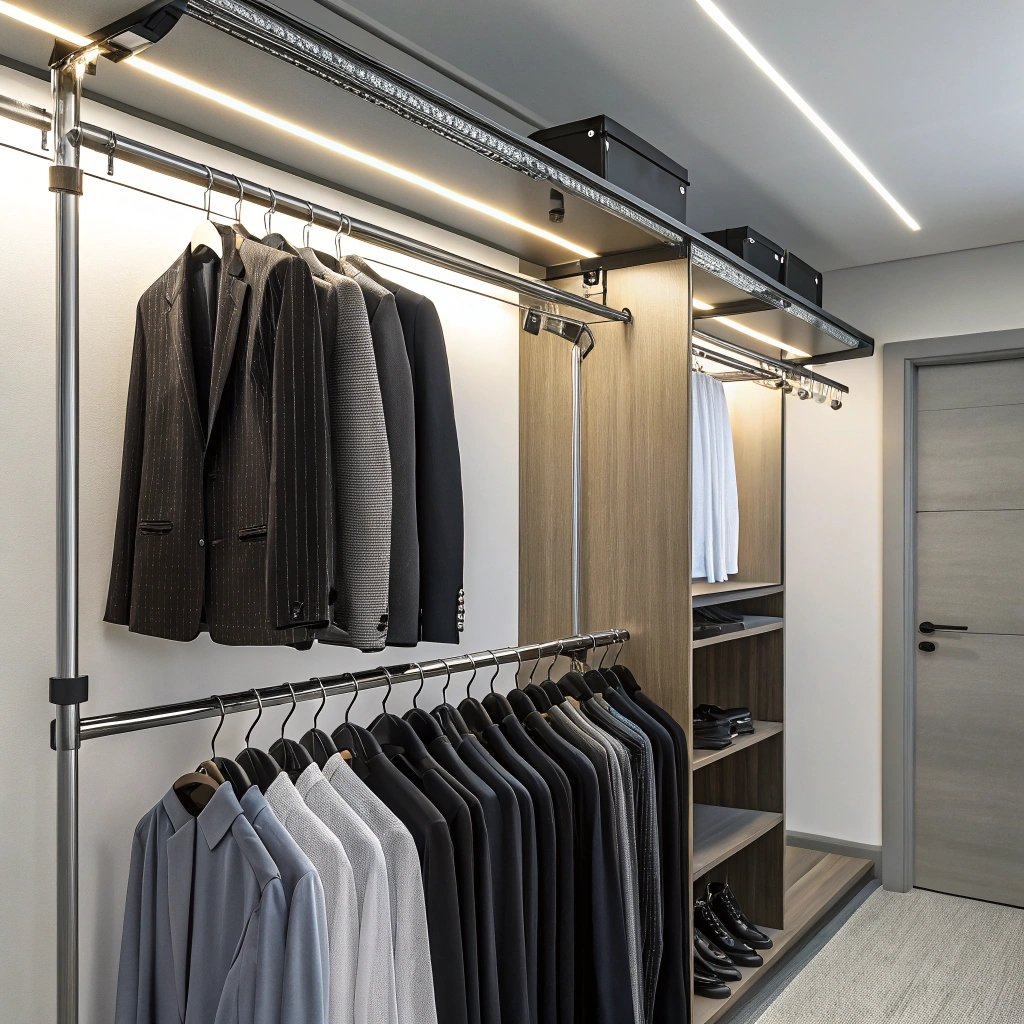
Two levels of hanging instantly double capacity. Vertical standards with 32mm increments let you tweak rail positions as seasons change.
Keep one bay single-hang for dresses and long coats and balance with a shelf above for baskets or hats. Uniform hangers stabilize spacing and visually de-stress the rail.
What makes this unique:
Install a pull-down wardrobe lift for the top rail and mark favorite settings with subtle stickers inside the uprights. Add color-coded hanger clips to stage outfits-in-progress.
The entire system adapts as your closet does, without calling a carpenter—function that grows with you.
8) Shoe Gallery Wall
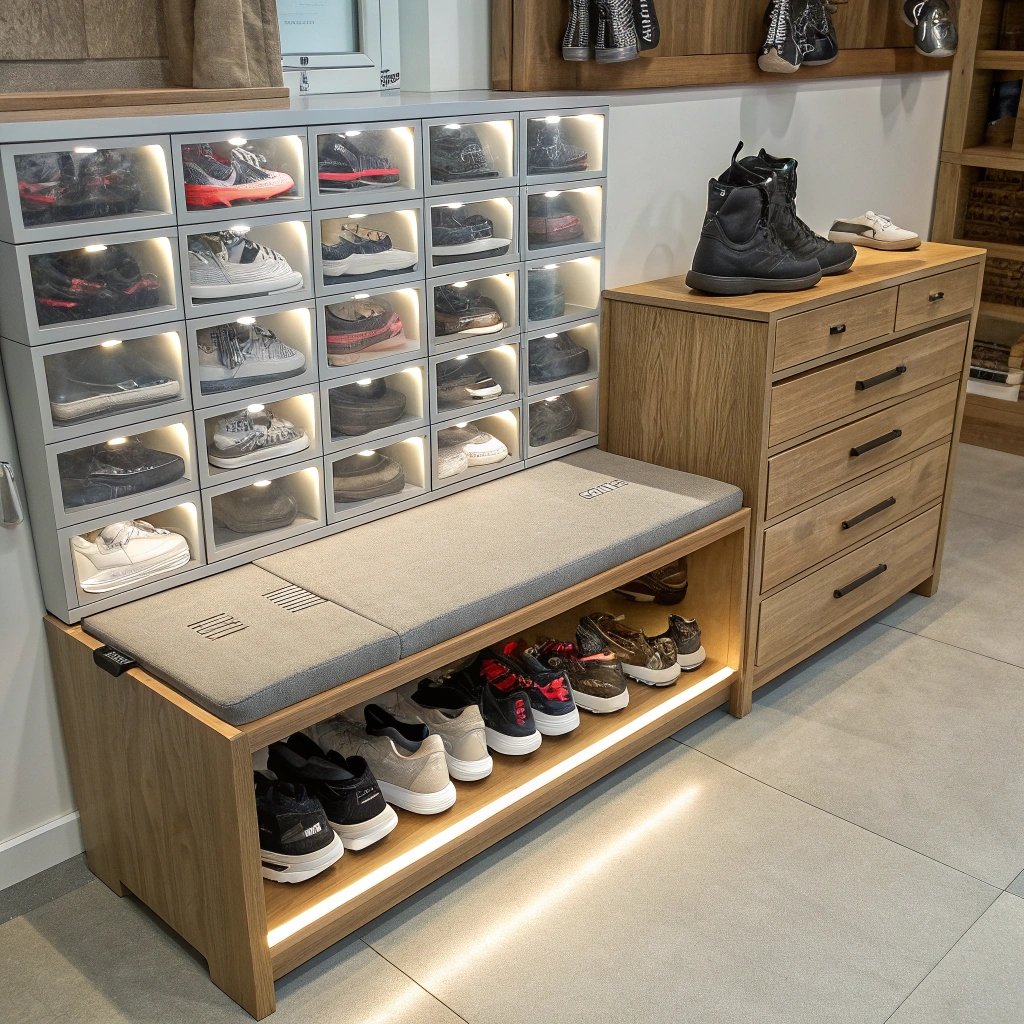
Turn footwear into art with shallow shelves or pull-out trays that face pairs forward. Alternate toe-to-heel to save space, use clear drop-front boxes for sneakers, and clip shapers to keep boots upright.
Add a low bench and a hidden tray for care kits so cleaning and culling happen where the shoes live.
What makes this unique:
Divide the wall into daily, seasonal, and special zones for quick swaps. Undershelf LEDs reveal colors at a glance and help dry damp soles.
With everything visible in one glance, you’ll actually wear more of what you own and retire what you don’t—no more lost pairs.
9) Drawer Systems That Actually Stay Organized
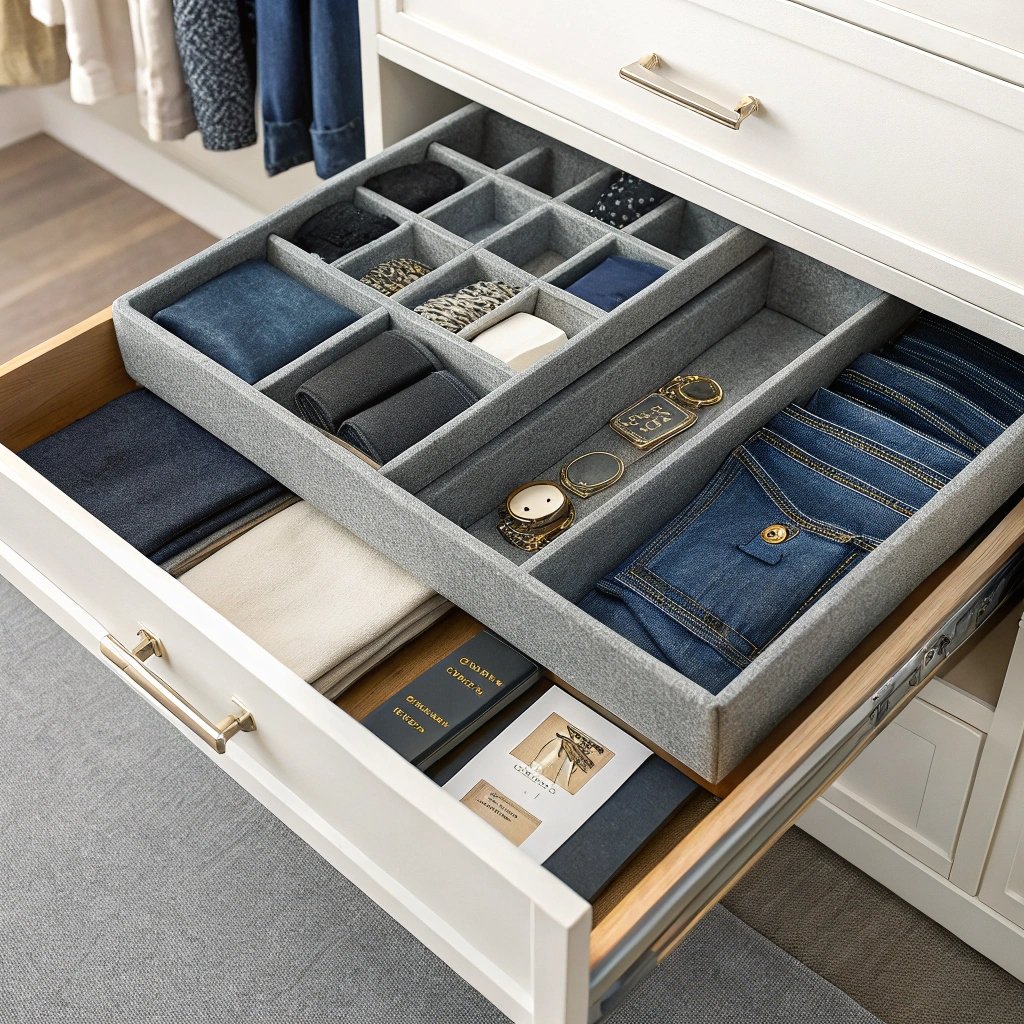
Drawers become productive when compartments match your items. Combine modular dividers for socks, underwear, scarves, and athletic gear.
Keep jewelry and watches in velvet-lined trays, then assign deeper drawers to denim and knitwear held upright with spacers. A top-down view makes putting away laundry a two-minute win.
What makes this unique:
Add washable felt or cork liners to quiet movement and protect fabrics. Slip a “reset card” under the front tray showing the intended layout so anyone can restore order.
Repeat divider finishes throughout for visual continuity. The system looks intentional and works even on hectic mornings.
10) Capsule Bay for Mix-and-Match Weeks
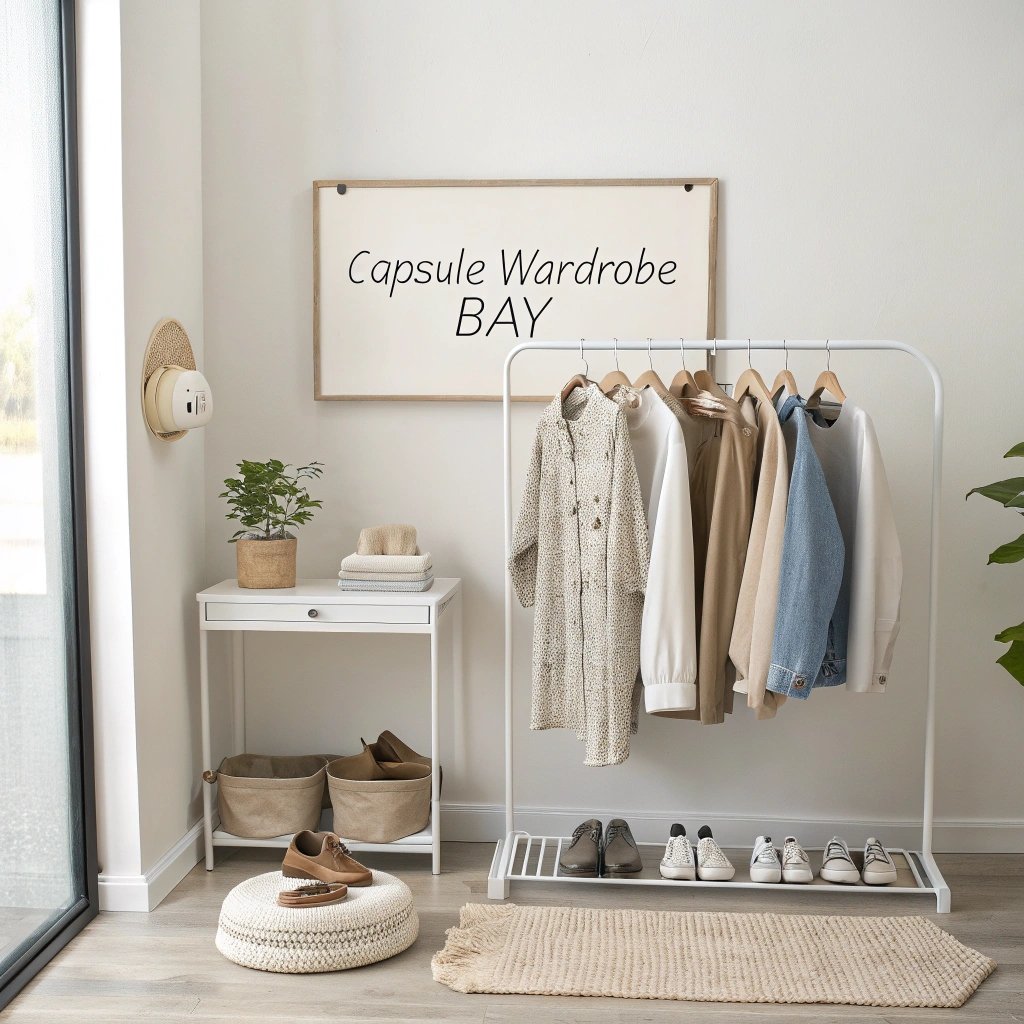
Dedicate one bay to a weekly micro-wardrobe: seven to ten pieces that mix effortlessly, two shoes, and a small tray for everyday jewelry.
Keep a narrow shelf for grab-and-go sweaters or a blazer. This “closet within a closet” slashes decision fatigue and keeps the rest of the wardrobe optional instead of overwhelming.
What makes this unique:
Use colored hanger tags (Mon–Sun, Work/Weekend) and a tiny whiteboard for favorite combos. Refresh the bay each season without reorganizing the whole space.
You’ll repeat great looks on purpose and shop smarter because gaps are obvious. The capsule turns style into a satisfying routine.
11) Lighting Layers and Smart Scenes
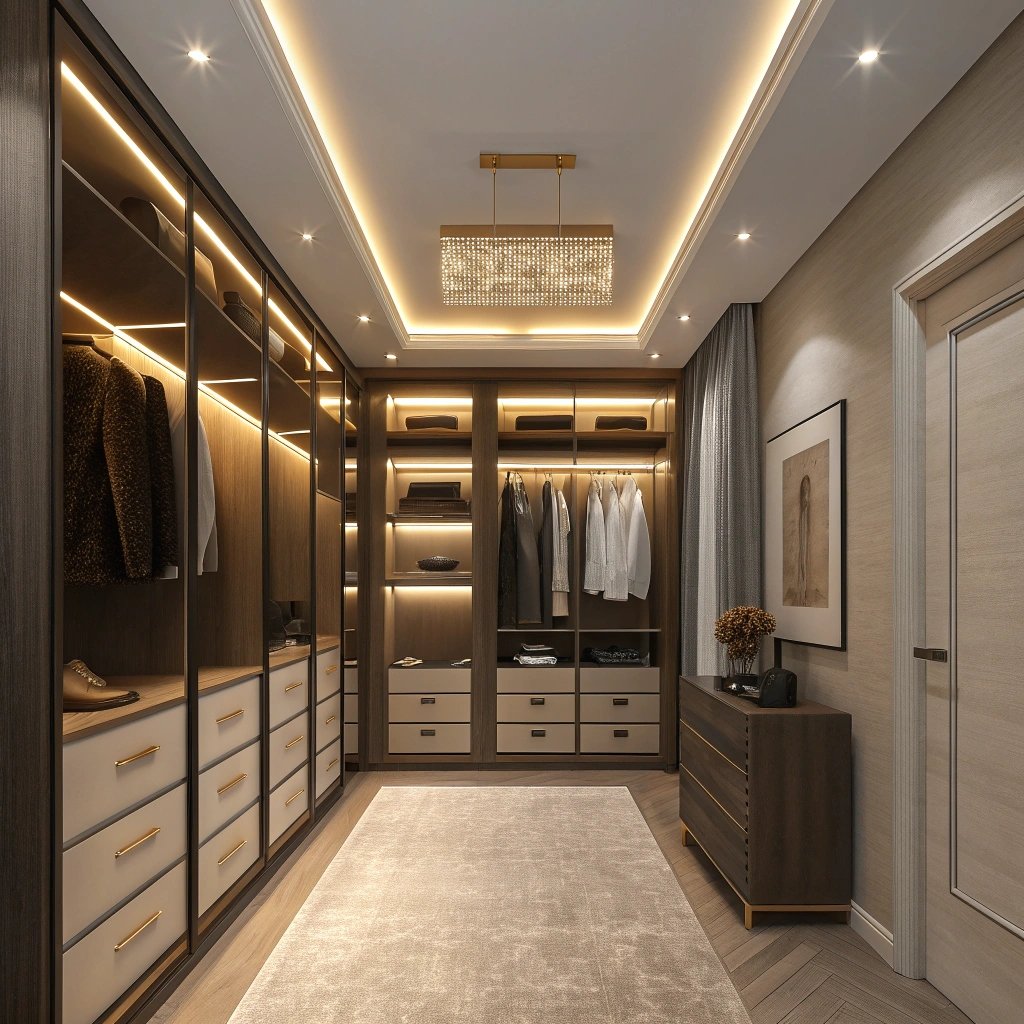
Great closets glow from multiple sources: recessed ceiling lights, vertical LED strips on uprights, and drawer lighting that activates when opened.
Warm temps (2700–3000K) flatter fabric colors and skin, while toe-kick LEDs guide early mornings. Smart dimmers store presets for Pack, Dress, and Clean-Up modes.
What makes this unique:
Graze textured fronts for boutique drama and add a tiny picture light over your display shelf. Choose high-CRI LEDs so blacks read true and whites don’t go green.
Motion sensors handle hands-free moments; you’ll never fish for a switch mid-steam again. The lighting plan becomes part of the design language.
12) Two-Tone Craft: Wood + Super-Matte Lacquer
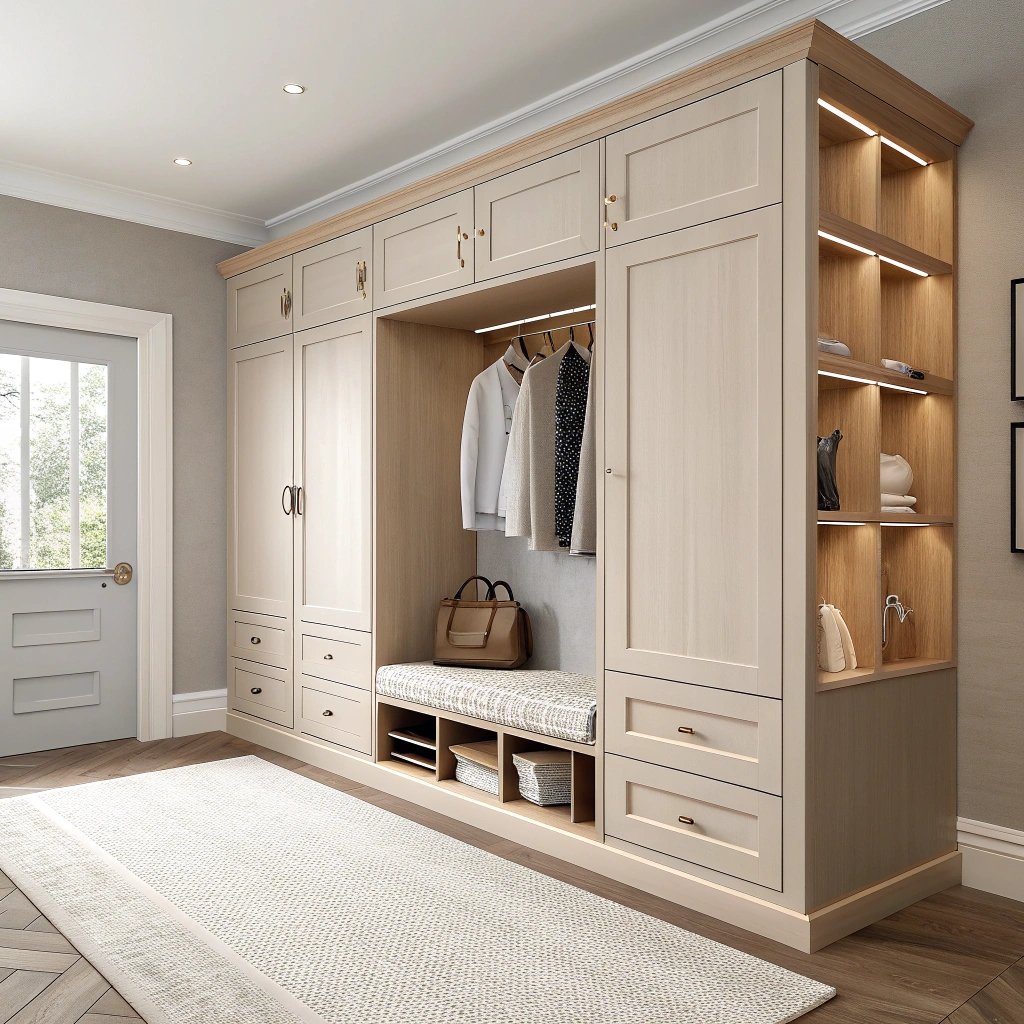
Mix natural wood with super-matte lacquer to balance warmth and order. Use wood at touch points (handles, seat, shelves) and lacquer on large planes.
The contrast creates depth without busy grain everywhere, and the matte finish hides fingerprints better than gloss—beautiful and forgiving in daily life.
What makes this unique:
Repeat materials deliberately: same species of wood across cantos and accessories; same lacquer tone on doors and sides.
Choose satin nickel hardware for a quiet bridge between temperatures. The two-tone scheme becomes your brand—sophisticated, easy to pair with any wardrobe palette, and timeless in photographs.
13) Soft Industrial Frame
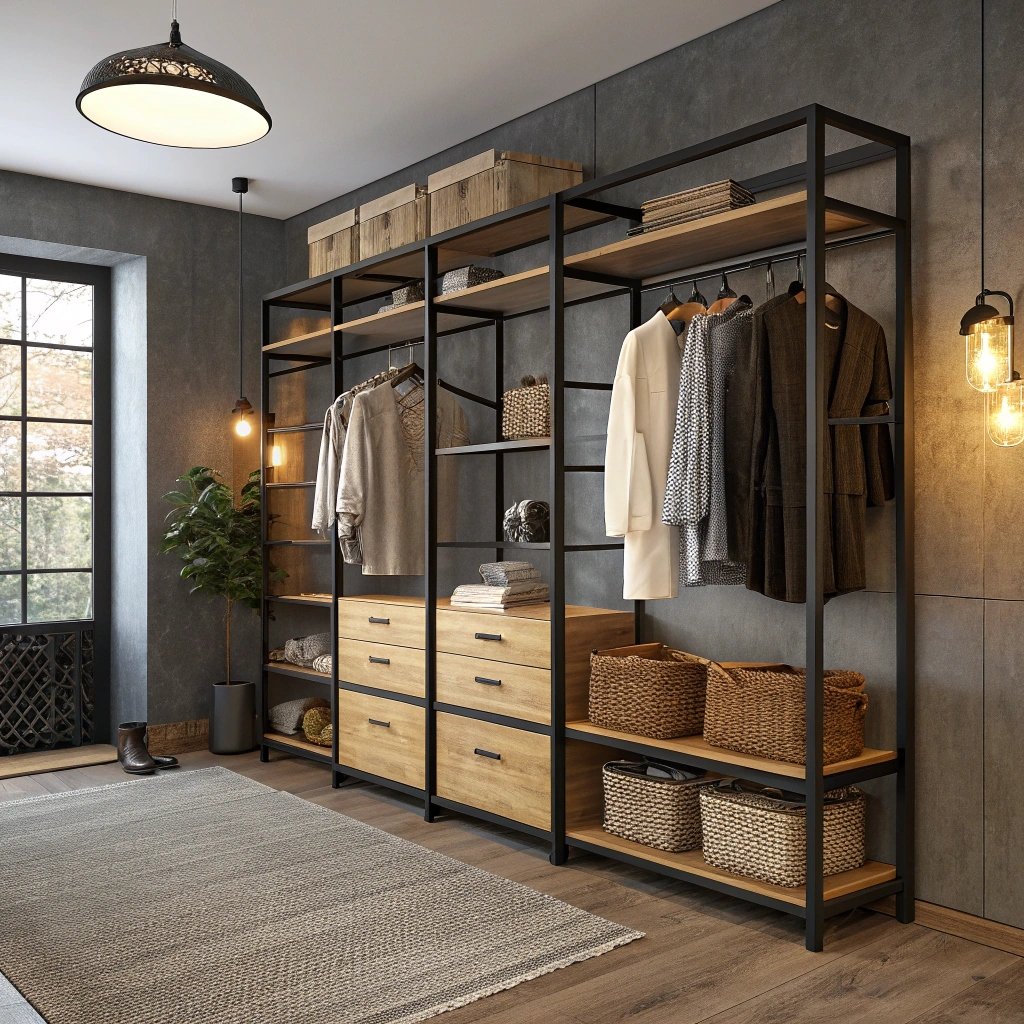
Open metal framework in black pairs with oak shelves and mesh baskets for a loft feel that still reads warm. Painted conduit aligns with the uprights so lines feel intentional.
Add dimmable factory sconces and a jute runner to soften acoustics. Airflow keeps gym kits and denim fresher between wears.
What makes this unique:
The “hard + soft” mix is the secret: steel and mesh for durability and ventilation; wood and fiber for comfort. Clipboards on a peg rail handle seasonal edit notes.
Under-shelf light strips provide real task illumination without killing the industrial vibe. It’s functional, characterful, and easy to reconfigure.
14) Sustainable, Low-Tox Closet
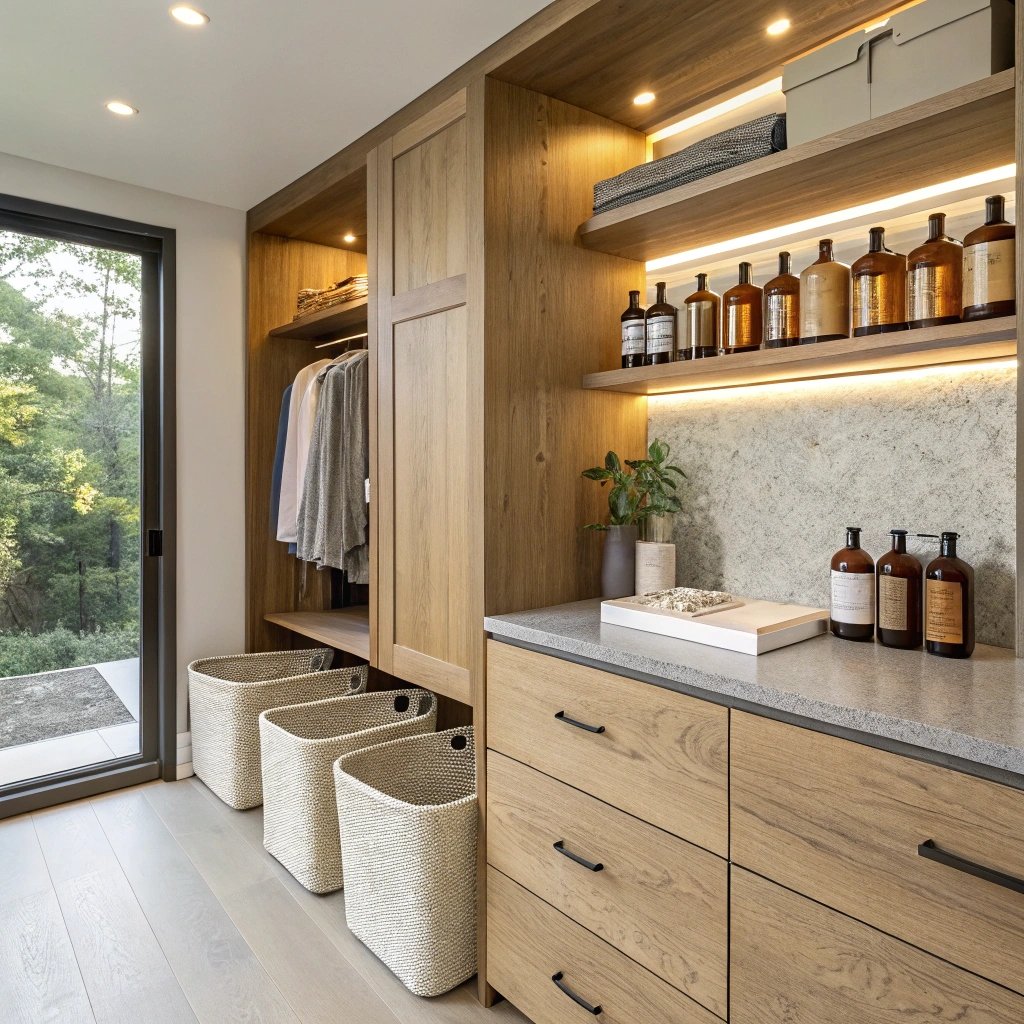
Design for longevity and health: FSC or reclaimed wood, water-based finishes, and durable sintered stone tops.
Choose solid-brass hardware that patinas, high-CRI LEDs for accurate color, and effective ventilation to care for fabrics. Refillable bottles and linen bins reduce plastic and visual clutter while looking chic.
What makes this unique:
Sustainability shows up in texture and maintenance, not slogans. Plan a recycle nook for hangers and paper, plus cedar inserts or lavender sachets instead of chemical deodorizers.
Materials wear in—not out—so the closet improves with time and costs less to keep beautiful.
15) Family-Friendly or Shared Closet
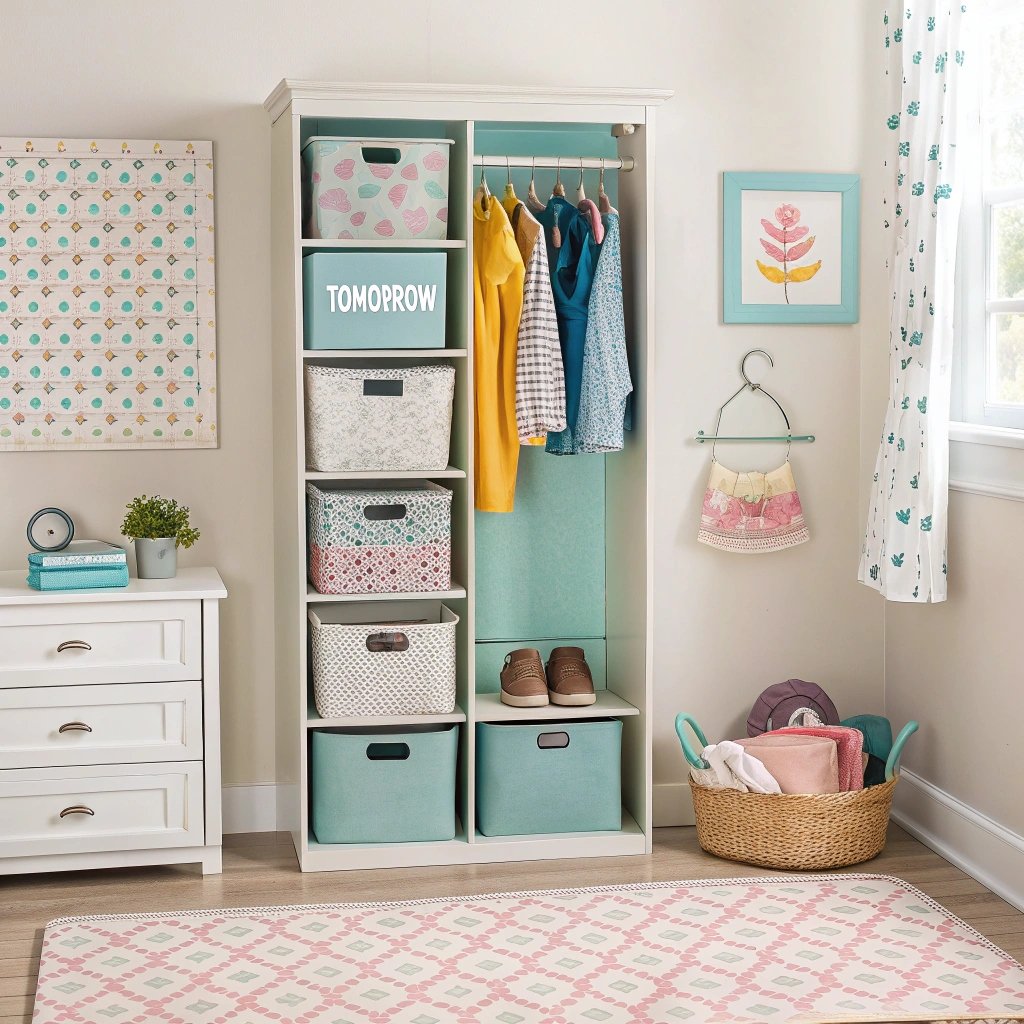
Build flexibility in from day one. Adjustable rails, shelves that move with changing heights, and sturdy, easy-open hardware encourage independence.
Use icon labels for pre-readers and swap to words later. Place everyday outfits at kid-eye level and stash extras higher. The system shifts as fast as the wardrobe does.
What makes this unique:
Add a “tomorrow hook” for outfit prep and a weekly caddy for activities (sports, swim, art).
For shared spaces, color the labels—not the bins—so zones can be reassigned without buying more components. It’s adaptable, budget-smart, and the calm holds even when life gets messy.
Quick Tips to Nail These Closet Designs
Choose one hero move (sliding facade, island, or lighting) and support it with two simple tweaks.
Standardize bins, hangers, and hardware finishes—visual cohesion makes any closet feel larger.
Set a quarterly calendar reminder for rotate-and-reset; maintenance is the magic that keeps everything effortless.

